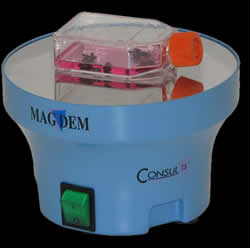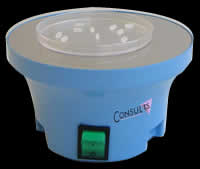| MAGDEM is the simple way to obtain cell suspension from cultures. |
view technical features view brochure
|
Introduction to the System
 Cells adherent to plastic disposable containers generally must be detached as a cell suspension prior to enter any experimental design and/or be re-seeded again in a new culture container. This step is generally achieved by means of enzymatic treatment. The use of enzymes has been introduced to overcome the disadvantages (tedious and time consuming) of manual detachment performed by “scrapers”. MAGDEM has been developed in order to emulate, improve and automate the manual procedure with the aim to speed up, simplify and standardize as much as possible the cell culture handling. Cells adherent to plastic disposable containers generally must be detached as a cell suspension prior to enter any experimental design and/or be re-seeded again in a new culture container. This step is generally achieved by means of enzymatic treatment. The use of enzymes has been introduced to overcome the disadvantages (tedious and time consuming) of manual detachment performed by “scrapers”. MAGDEM has been developed in order to emulate, improve and automate the manual procedure with the aim to speed up, simplify and standardize as much as possible the cell culture handling.
MAGDEM is a system composed by two parts: a) the magnetic field generator and b) the mobile scrapers (FLYcons) driven by the field. Both are advanced devices designed and engenerized with test trials in cell culture lab who did take into account all the specific needs of cells handling. MAGDEM is equipped with a series of permanent magnets (no electromagnetic field!!) whose force is calibrated according to the FLYcons mass. Magnet array is made to accurately scan all the system surface (holding the cell container) via an iterative mode. FLYcons are particularly innovative in both the material and shape (patent pending): biologically inert plastic with a proper ratio of paramagnetic particles enough to be “gently” driven by the magnetic field . They are properly sized and shaped (x cross-section) to gently move all over the surface were they have to work.
|
|
Instruction procedure
MAGDEM can perform cell detachment in the most common plastic containers: round (Petri dishes) or square (Flasks) as single or “multi-wells” format. The procedure can be applied directly to samples still in the culture medium in the plastic container, or in any other washing buffer (after medium removal).
|
|


|
-
Take the culture container and check the liquid level: it is the only important pre-requisite to operate in the correct mode. When “FLYcons” will be introduced in the container they must freely-float in the liquid (they will later stick to the cell layer when the magnetic force will keep them working). As a general suggestion a dept of about 3mm of liquid is the quantity that guarantee the correct procedure. As an example in a Flask of 50ml the proper level of liquid should be around 10ml (more or less the suggested quantity of medium required) for best results.
-
Put the FLYcons inside the container taking into account (or not) the sterile condition eventually required.
-
Gently shake the container in order to allow all the pieces floating in the liquid.
-
Place the container with FLYcons over the surface of the MAGDEM and checking they are attracted to stick down to the cell layer.
-
Switch on the MAGDEM unit and see the FLYcons move all over the surface of the container.
-
Live MAGDEM operate for few minutes (generally 5mins is the suggested time and is related to the kind of cell and shape of plastic containers: round shaped are fasten operated as compare to other types).
-
Switch off the unit and check visually (or, better, with an inverted microscope) if all the adherent cells have been removed from the plastic surface. If not repeat the above step for other few minutes.
-
Remove cell suspension from the container by plastic or glass pipette living the FLYcons inside the containers (FLYcons can also by blocked with an external piece of magnet and container turned up-down).
|
|
Note
FLYcons are biologically inert and made sterile so they can stay in culture for long time without any cell-interactions. Cell re-culturing in the same container is therefore possible allowing to save time and money to the culture facility.
MAGDEM procedure is free of any chemicals and/or enzyme components thus do not contaminate the obtained cell suspension with any possible interference with cell growth and proliferation. Cell membranes may be only mild “mechanically damaged”. As far as viability tests are concerned cells can be often labelled by Propidium Iodide, but it has been proved to be a reversible-damage while these cells are able to easily restart growing during re-culturing process.
|